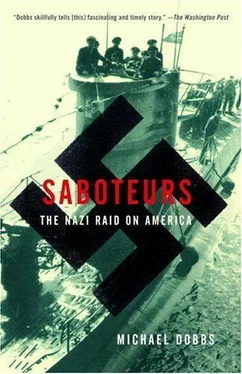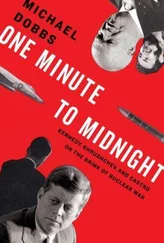Half an hour after the announcement, Roosevelt left the White House for his new retreat in the Catoctin Mountains in Maryland, a two-hour drive north of Washington. He called it Shangri-La because of the secrecy that surrounded the place and its isolated, invigorating quality. (Later presidents would know the retreat as Camp David.) Although Roosevelt loved to go to Hyde Park, it was becoming increasingly difficult for him to make the overnight train trip to upstate New York. Shangri-La was close enough to Washington that he could go there most weekends with a few friends, in an atmosphere of informality and relaxation.
On this particular weekend, the president was accompanied by his usual circle of intimates: Daisy Suckley, his secretary Grace Tully, and his friends Samuel Rosenman and Archibald MacLeish, together with their wives and a few Secret Service men. It was still raining heavily when they got to Shangri-La, and inspected their rustic quarters. Roosevelt “gleefully” informed his guests that they would all have to share a single bathroom with a door that never closed quite securely. As president, he claimed the master bedroom with attached bathroom. They would all share the casual living-dining room and screened-in porch with a magnificent view overlooking a valley.
That evening, Roosevelt busied himself with a much-loved ritual, mixing cocktails. At dinner, he reminisced about his days as governor of New York, when he had to decide whether to pardon murderers with the help of Rosenman, his longtime legal adviser and speechwriter. He also entertained his guests with a series of gruesome stories inspired by the executions of the six saboteurs. 26
One of the stories the president related with gusto was about a barber during the final days of the siege of Paris, in 1871. Everybody was starving, but somehow the barber managed to supply excellent “veal” to the local butcher. Throwing his huge head back with laughter, Roosevelt described how suspicions spread that the “veal” had come straight from the barber’s chair as a number of his customers had gone missing. He piled detail on grisly detail, until Ada MacLeish began to shiver. The wife of the poet and librarian of Congress remarked that she might also make good “veal,” as she was slightly plump.
The guests understood that telling such stories was a way for the president to unburden himself from the cares and responsibilities of his office. American troops had just landed at Guadalcanal in the Solomon Islands, on the first stage of what would be a three-year island-hopping campaign in the Pacific. Casualties were high. Reports were also coming in of a disastrous naval engagement near Savo Island, where the Allies had lost four cruisers.
The next morning, after receiving a briefing from his naval aide, Captain McCrea, about the progress of the war, Roosevelt resumed his macabre tales. He retold one of his favorites, about a wealthy Chicago widow who died in Moscow while on a world tour. Her coffin was shipped back to Chicago for burial but, when it arrived, her relatives were horrified to discover the body of a dead Russian general in full military regalia. They sent a telegram to the U.S. embassy in Moscow to find out what had gone wrong, and received the following reply: “Suggest you close the casket and proceed with the funeral. Your grandmother was buried in the Kremlin with full military honors.”
Mrs. Rosenman asked the president what would happen to the bodies of the saboteurs. Roosevelt avoided giving her a direct answer. That was one of the matters he had just been talking about with Captain McCrea, he said.
THE PRESIDENT was determined that no trace remain of the saboteurs. He did not want their graves to become a place of ghoulish pilgrimage for Nazi sympathizers. At his instructions, all the clothing that had belonged to the V-men, including the new suits they had bought in New York, Jacksonville, and Chicago, was incinerated. 27Contrary to normal regulations, no reports of their deaths were filed with the public health authorities in Washington.
After lying for two days in the morgue of the army medical center, the bodies were placed in plain pine boxes at 6 p.m. on Tuesday, August 11. A light truck took the coffins under armed guard to a graveyard for unclaimed bodies on the southernmost edge of the District of Columbia, on a lonely hill adjoining the sewage disposal facility of Blue Plains. Six graves had been prepared with crude wooden headboards marked only with numbers, from 276 to 281. A six-foot-high wire mesh fence separated the saboteurs’ graves from the paupers’ graves. A stench of sewage wafted up the hill, which lay high over the Potomac River.
At 7:30 p.m., two army chaplains, one Protestant, one Catholic, said some prayers as the bodies of the six saboteurs were laid to rest. No photographs were taken, and no information given to the press. Only two copies were made of the report on the disposal of bodies. One went to the president, the other to the secretary of war. Both were stamped SECRET. 28
Operation Pastorius—the high-risk gamble that Hitler hoped would lead to the crippling of the American war machine—had come to an ignominious and unmourned end.
GEORGE DASCH and Peter Burger learned about the fate of their six companions when they were taken on their regulation fifteenminute walk around the cell block. The cells previously occupied by the men who had trained with them in Brandenburg were empty. Both Dasch and Burger were tortured by the thought that they had sent their fellow saboteurs to their deaths.
Dasch kept asking the army guards if he did “the right thing” by reporting the sabotage plot to the FBI. On Saturday night, he had trouble getting to sleep, as he thought about everything he had done since arriving in America eight weeks earlier. “I have died six deaths,” he told one of his guards. 1On Sunday morning, however, he ate a “hearty breakfast” and began talking more coherently to the guards about his own situation.
He was still “extremely pale and haggard looking,” almost ghostlike, when the two FBI agents who had most to do with his case, Duane Traynor and Mickey Ladd, visited the D.C. jail on Wednesday morning. 2He could not get used to the idea that he had been sentenced to thirty years in prison, and broke down when he realized that the agents had not come to let him out of jail. “You may think you came over here to help us, but you have to understand the attitude of the American people and the U.S. government,” they told him. “As far as Americans are concerned, you were a saboteur who landed from an enemy submarine.”
Burger also felt remorse about informing on his comrades. The two FBI men tried to allay his conscience by claiming they knew in advance that Dasch was coming over to America. They told Burger that it was only a “question of time” before they rounded everybody up, and therefore he should not feel responsible for the deaths of his comrades. Hearing this, Burger felt better.
Both the surviving saboteurs said they wanted to do everything in their power “to fight Hitler.” The agents promised to pass their ideas “to the right places,” but gave them little hope of early release from prison. A few days later, the prisoners were transferred to the newly vacated “death house” of the D.C. jail, where they occupied adjoining cells. 3They were allowed to talk to each other and their guards—in English—but otherwise were kept isolated from the rest of the prison. After a few weeks, they were sent to the federal prison in Danbury, Connecticut.
In October, Burger appeared as the star prosecution witness in the treason trial in Chicago of the Haupts, the Froehlings, and the Wergins. (Dasch was considered too unreliable to testify.) 4All six defendants were found guilty, largely on the basis of their incriminating statements to the FBI. Judge William Campbell sentenced the three men to death, and the three women to twenty-five years in prison and $10,000 fines. The harsh sentences earned Campbell, a hard-line former U.S. attorney, the plaudits of the press and the nation, but were reversed on appeal, partly because of the controversy over whether FBI statements could be admitted as evidence. Haupt was eventually sentenced to life imprisonment, but was released in 1957; Walter Froehling and Otto Wergin got five-year prison terms; Erna Haupt was interned; the other two women were released.
Читать дальше












